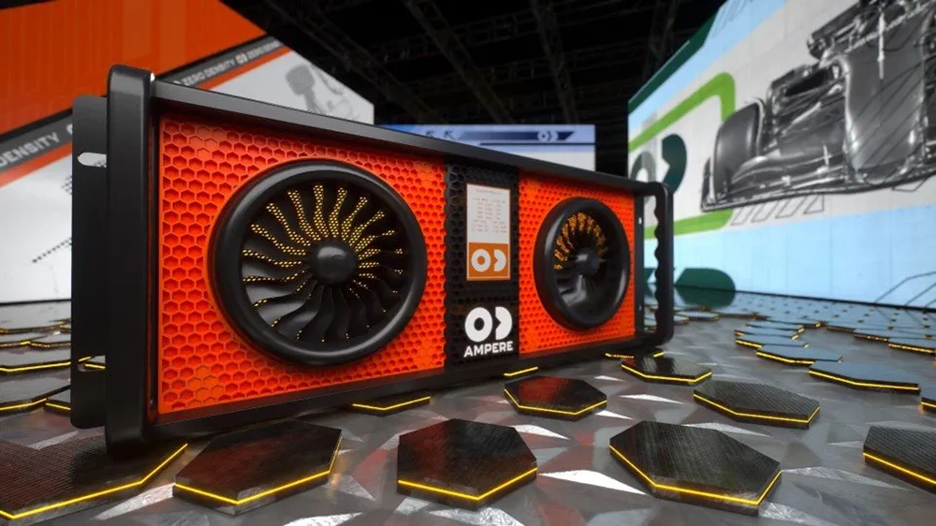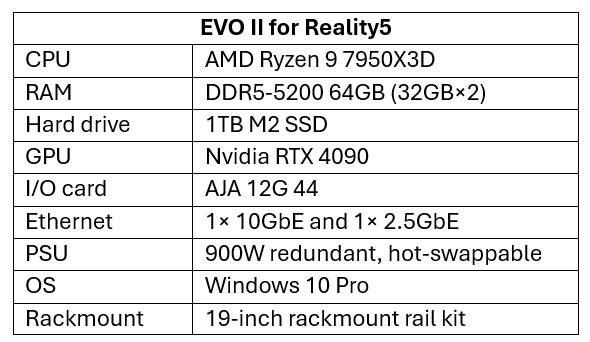
When Zero Density released Reality5, the latest version of its real-time virtual production platform, it needed an engine that could maximize the capabilities for users. Yet, the company said it was unable to find any render hardware capable of providing the render performance to optimize Reality5’s capabilities and had the endurance capabilities needed for broadcast. So, it built the EVO II render engine, using some off-the-shelf components (GPU and CPU) that met its specifications and others that it devised internally. The result is what Zero Density is calling the most advanced real-time production render hardware platform on the market. In addition to announcing EVO II at NAB 2024, the company introduced Lino, a 2D and 3D motion graphics editor powered by Epic’s Motion Design tools (previously Project Avalanche), for creating motion graphics and more.
What do we think? Zero Density is focused on using a game engine in a real-time broadcast realm. For the past several years, it has not only achieved that goal, but continues to build on it with new hardware and software offerings. It is making an impact and catching attention, having received NAB awards for two of its products, one in 2022 and another in 2023. Is one more such award in its future? We will find out shortly when NAB ends, but it seems like a good bet with EVO II.
Zero Density introduces EVO II render engine, Lino motion graphics editor
A few years before The Mandalorian and The Lion King made virtual production the new star, R&D start-up Zero Density began delving into virtual production technology and soon began making a name for itself with integrated real-time graphics and virtual set production solutions. Continuing to move the needle forward with new offerings that have won accolades at the past two NAB conferences, Zero Density has introduced the EVO II render engine and Lino, a real-time motion graphics platform, at this year’s NAB in Las Vegas.
EVO II is not your typical render engine. It was engineered for one purpose: ultimate performance in game engine-based real-time virtual production.
Back in 2016, Zero Density began its quest to use a game engine in broadcast and have the graphics running in real time with the same quality and speed in postproduction as it does in games. This led to Zero Density’s claims of introducing the first virtual production platform using Epic’s Unreal Engine. Fast-forward to November 2023 when Zero Density released the Reality5 real-time virtual production platform, which moved all the node-based compositing video I/O capabilities completely outside the engine. Reality Version 5 was developed with an all-new architecture, allowing the company to introduce new features with greater ease. There was just one problem: Zero Density said it could not find any render hardware capable of providing the render performance to optimize Reality5’s capabilities and had the endurance capabilities needed for broadcast.
Kuban Altan, a co-founder of Zero Density and head of R&D, said the company still wanted to utilize the bleeding-edge CPU and GPU for games, including requirements such as rackmountability, redundant power supply, reliability, 24/7 operation, and the necessary cooling.
Enter EVO II, which has been retooled for the Zero Density Reality5 and optimized for virtual production and real-time motion graphics. The rendering engine is especially designed for endurance and performance, and is purpose-built for game engine-based, real-time rendering, compositing , and video I/O for virtual production. EVO II also streamlines the asset creation and integration processes with a single graphics process using Zero Density’s Reality Hub, eliminating the need for multiple software solutions.
When developing EVO II’s architecture, the company said it looked at maximizing what Ralf van Vegten, CMO at Zero Density, calls the four biggest performance influences—the CPU, GPU, power delivery system, and thermal management—when rendering using a game engine like Unreal Engine. They reviewed every component, he said, and when commercial components were not up to snuff, the company developed their own, resulting in what it calls “the most advanced real-time production render hardware platform on the market today.” A bold statement, yes. But on the surface, it looks like Zero Density is not just blowing hot air.
The EVO II rendering engine for Reality5 comprises an Nvidia RTX 4090 GPU and an AMD Ryzen 9 7950X3D CPU, along with Zero Density’s own power distribution platform. Van Vegten said they chose the RTX over a Quadro, despite the RTX 4090 having fewer tensor cores, fewer ray-tracing cores, and less VRAM than the Quadro, due to the number of watts being fed into the GPU, finding that the performance for game-engine rendering is 32% higher compared to the Quadro and 160% for the first version of the Ampere. But to make the RTX 4090 reliable in 24/7 broadcast operations, the power distribution had to be severely modified. Because the engine is air-cooled, the team redesigned the internal chassis to eliminate clutter and maximize airflow. EVO II also uses M2 SSDs rather than traditional SATA connections, achieving low latency by using the mini PCI bus.

Altan added that the company will be keeping up with the latest GPUs and CPUs for gaming as they become available and updating the EVO II hardware as needed to maximize game engine performance.
Meanwhile, a single board computer monitors temperature and CPU/GPU data, ambient temperature and humidity, cooling fan speed, and the status of the redundant power supply. It also detects any motion of the chassis. The information concerning its physical and operational status can be accessed by the Reality Hub monitoring system as well as the touchscreen display on the front of the EVO II chassis.
Zero Density said its EVO II hardware platform plus Reality5 virtual production platform integrate seamlessly into any broadcast environment.

In other news, Zero Density introduced Lino, a 2D and 3D motion graphics editor powered by Epic’s Motion Design (previously Project Avalanche), a set of tools in the newly released Unreal Engine 5.4 Preview for creating motion graphics and more. With Lino, users are able to generate all their production assets in Unreal Engine and use as video wall content, on-air graphics or preproduction motion graphics, and virtual production graphics—create once, use anywhere, if you will, for a faster and more cost-effective solution.
According to Zero Density, Lino increases rendering and compositing quality, particularly when it is paired with the company’s new EVO II render engine.
Zero Density offers a range of software and hardware products for virtual production with real-time visual effects, including the AI-powered markerless stereoscopic Traxis talent and camera tracking system.





